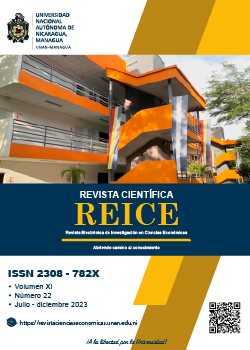Optimal working capital management: balancing liquidity and profitability in financial management
DOI:
https://doi.org/10.5377/reice.v11i22.17342Keywords:
Working Capital Management, Liquidity, ProfitabilityAbstract
This paper offers a comprehensive examination of the significance of working capital management within the realm of financial management. This paper examines the significance of working capital in sustaining a corporation's operations and its role in facilitating business success. The research also underscores the differentiation between gross and net working capital, as well as the characteristics of working capital management, with a particular focus on the interconnectedness between current assets and liabilities. The study aims to evaluate the financial situation of Sugar firm and offer insights into its operational efficiency and long-term financial sustainability. The authors have also highlighted the necessity of conducting this study within the framework of India's economic situation following liberalization. The research methodology section elucidates the origins of primary and secondary data employed in the study, so offering transparency into the process of data collecting. The study provided an analysis of several financial ratios pertaining to liquidity, inventory turnover, holding period return, changes in stock, and debtor turnover. The authors have conducted a comprehensive analysis of the ratios throughout multiple years, providing significant insights into the financial performance of the Sugar company. The findings have brought attention to important aspects, including the company's dependence on short-term sources of finance and the substantial impact of inventory and various debtors on gross working capital. The analysis has also highlighted the company's adherence to acceptable current and quick ratios, fluctuations in the absolute liquid ratio, as well as swings in inventory turnover and debtor turnover ratios. The ideas section offers practical advice for the organization, encompassing the maintenance of existing working capital management processes, enhancement of inventory management, and effective management of cash flows. In conclusion, the significance of working capital management is succinctly summarized, with a particular emphasis on its pivotal role in enhancing business performance, fostering growth, and facilitating modernization. The study article presents a comprehensive examination of the working capital management of Sugar firm and offers significant insights for the company's financial decision-making.
Downloads
1341
References
Akbar, A., Akbar, M., Nazir, M., Poulova, P., & Ray, S. (2021). Does working capital management influence operating and market risk of firms?. Risks, 9(11), 201.
Appuhami, B. (2008). The Impact of Firms' Capital Expenditure on Working Capital Management: An Empirical Study across Industries in Thailand. International management review, 4(1).
Dash, M., & Ravipati, R. (2009). A liquidity-profitability trade-off model for working capital management. Available at SSRN 1408722.
Forghani, M., Shirazipour, M., & Hosseini, A. (2013). Impact of working capital management on firms performance. Journal of Basic and Applied Scientific Research, 3(7), 943-947.
Nazir, M. S., & Afza, T. (2009). Impact of Aggressive Working Capital Management Policy on Firms' Profitability. IUP Journal of Applied Finance, 15(8).
Padachi, K. (2006). Trends in working capital management and its impact on firms’ performance: an analysis of Mauritian small manufacturing firms. International Review of business research papers, 2(2), 45-58.
Palombini, N. V. N., & Nakamura, W. T. (2012). Key factors in working capital management in the Brazilian market. Revista de Administração de Empresas, 52, 55-69.
Pass, C. L., & Pike, R. H. (1984). An overview of working capital management and corporate financing. Managerial Finance, 10(3), 1-11.
Smith, K. V. (1973). State of the art of working capital management. Financial management, 50-55.
Uremadu, S. O., Egbide, B. C., & Enyi, P. E. (2012). Working capital management, liquidity and corporate profitability among quoted firms in Nigeria: Evidence from the productive sector. International journal of academic research in accounting, finance and management sciences, 2(1), 80-97.
Zariyawati, M. A., Annuar, M. N., Taufiq, H., & Rahim, A. A. (2009). Working capital management and corporate performance: Case of Malaysia. Journal of Modern Accounting and Auditing, 5(11), 47.

Downloads
Published
How to Cite
Issue
Section
License
Copyright (c) 2023 Revista Electrónica de Investigación en Ciencias Económicas

This work is licensed under a Creative Commons Attribution-NonCommercial-ShareAlike 4.0 International License.
Copyright (c) Revista Electronica de Investigacion en Ciencias Economicas
The rights to the articles published in REICE are from the journal, in order to be able to manage their best dissemination. However, since the purpose of the same is the dissemination of knowledge, this journal provides immediate free access to its content, under the principle that making research available to the public free of charge, which fosters a greater exchange of global knowledge.
The opinions expressed by the authors do not necessarily reflect the position of the publisher of the publication or of the UNAN-Managua. Its reproduction and distribution is authorized (in any type of support) provided that the following indications are fulfilled:
- The authorship of the work
- Indicate its origin (REICE magazine, volume, number and electronic address of the document)
